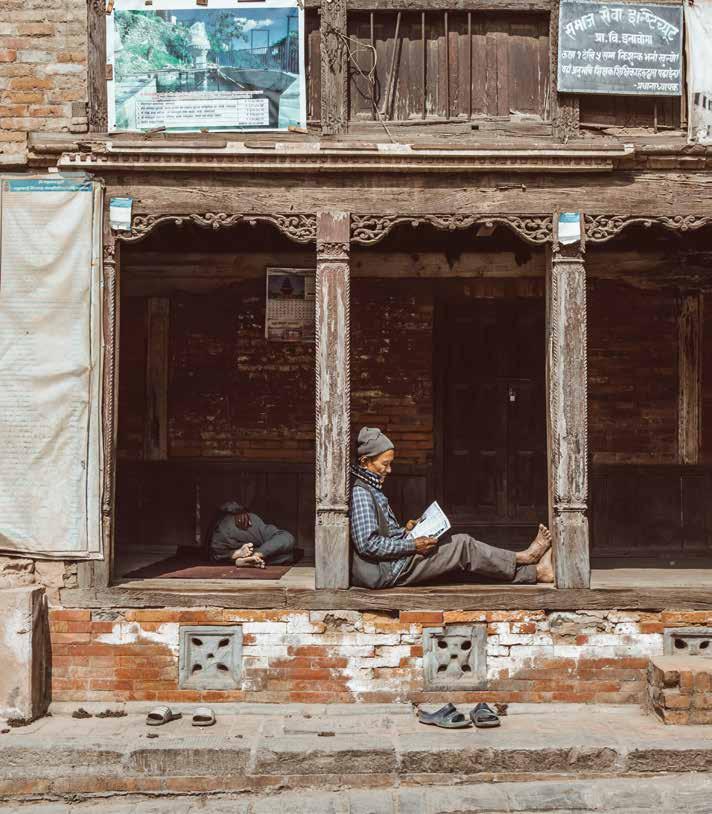The Explorer

The Magic of Thailand
New Destinations for 2025 ± Trekking in Turkey
Nepal’s Best-Kept Secrets ± A World of Books


New Destinations for 2025 ± Trekking in Turkey
Nepal’s Best-Kept Secrets ± A World of Books
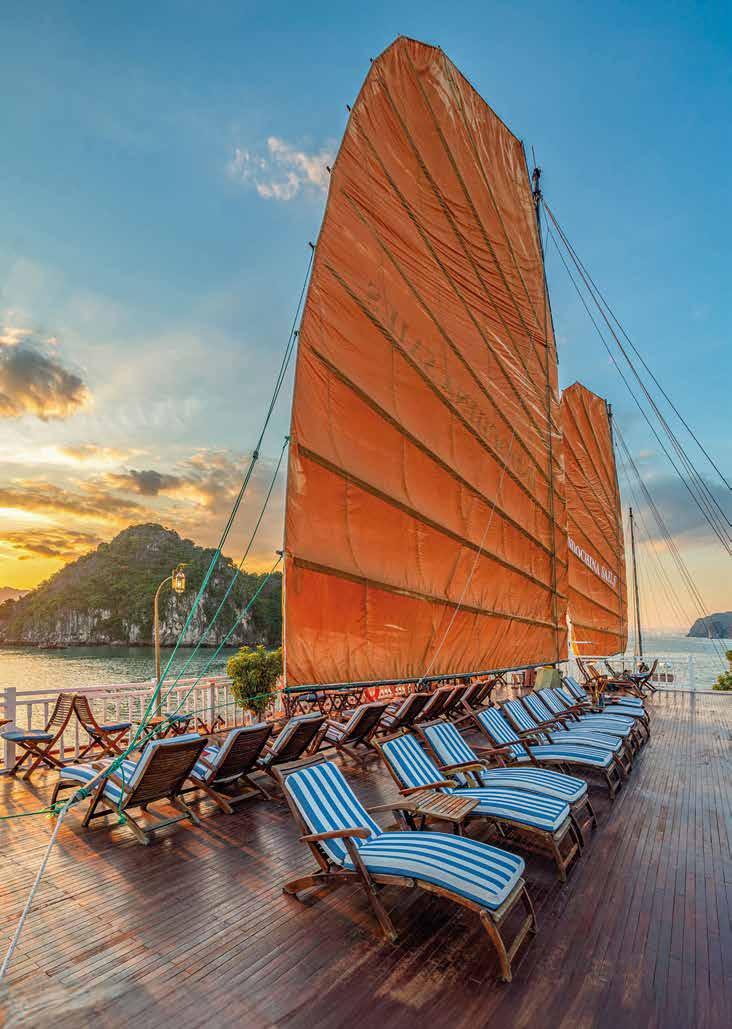

Our travels are so often inspired by reading – that’s part of the reason we started The Explorer magazine – and I’m delighted to introduce you in this issue to our newly-launched Four Corners Book Club. A place to read and recommend inspiring, delightful, and thought-provoking fiction set all across the world.
Reading certainly set me on the path to travelling, and travelling made me want to read more about the world and the people in it... These days taking a book or two on my travels is about as close to perfection as life can get! We hope you enjoy the Book Club, and look forward to seeing your recommendations.
Also coming up in this issue are rhinos in Nepal, a dive into the cultural significance of breakfast, and walking through the otherworldly landscapes of Cappadocia. We’re also lifting the lid on some of our brand new destinations and trips for 2025 – including Rwanda, Ghana, South Korea and the Faroe Islands. Bring it on!

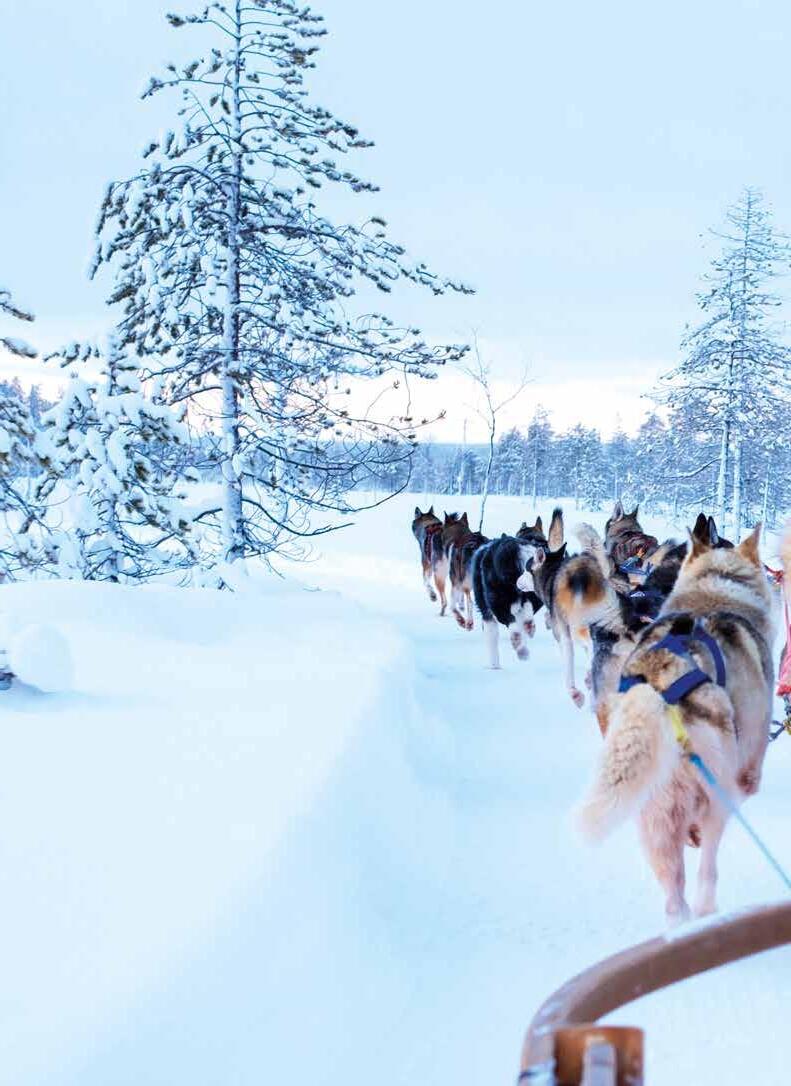
2025 is fast approaching, and we’re bursting with excitement to share some of our brand new destinations with you. Here are just some of the captivating new tours joining our programme for next year.
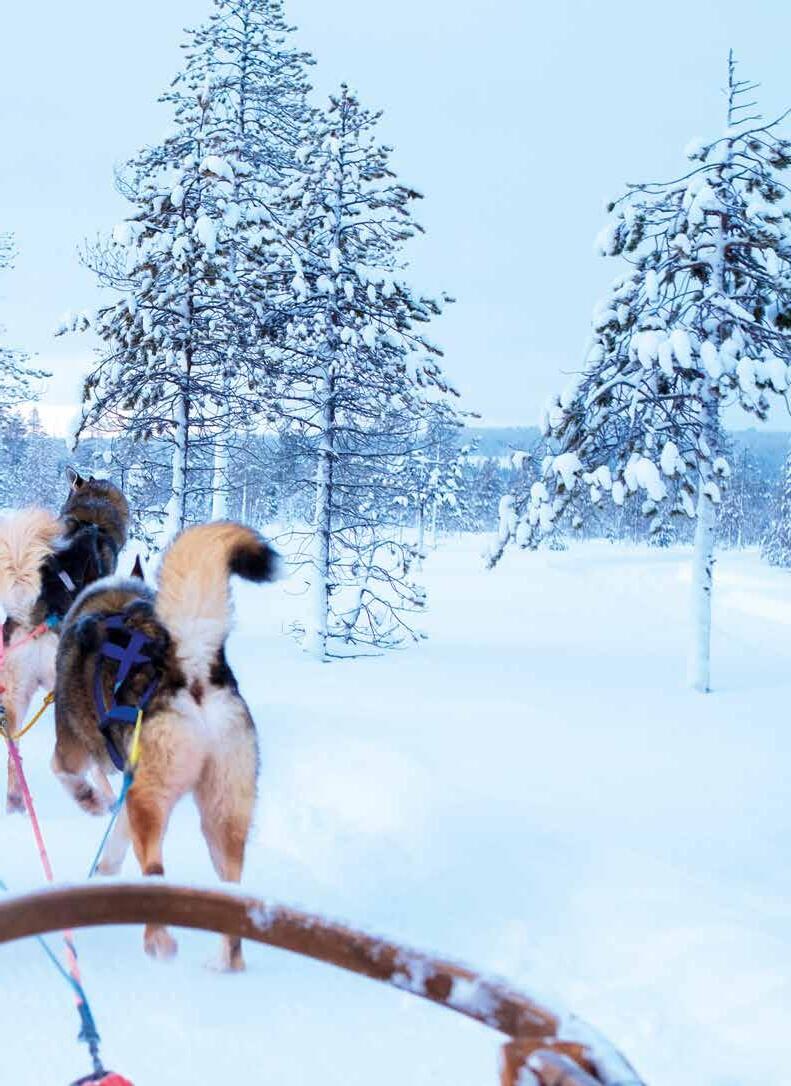
In this era of easy tourism there are still plenty of places to escape the crowds. Our new Finnish Lapland Winter Adventure takes visitors away from the more-seen areas served by charter flights and mainstream operators. We supply the thermal winter gear, equipment and your expert guide and all you need to do is turn up and be wowed by activities like cross-country skiing, husky sledding and Northern Lights viewing.
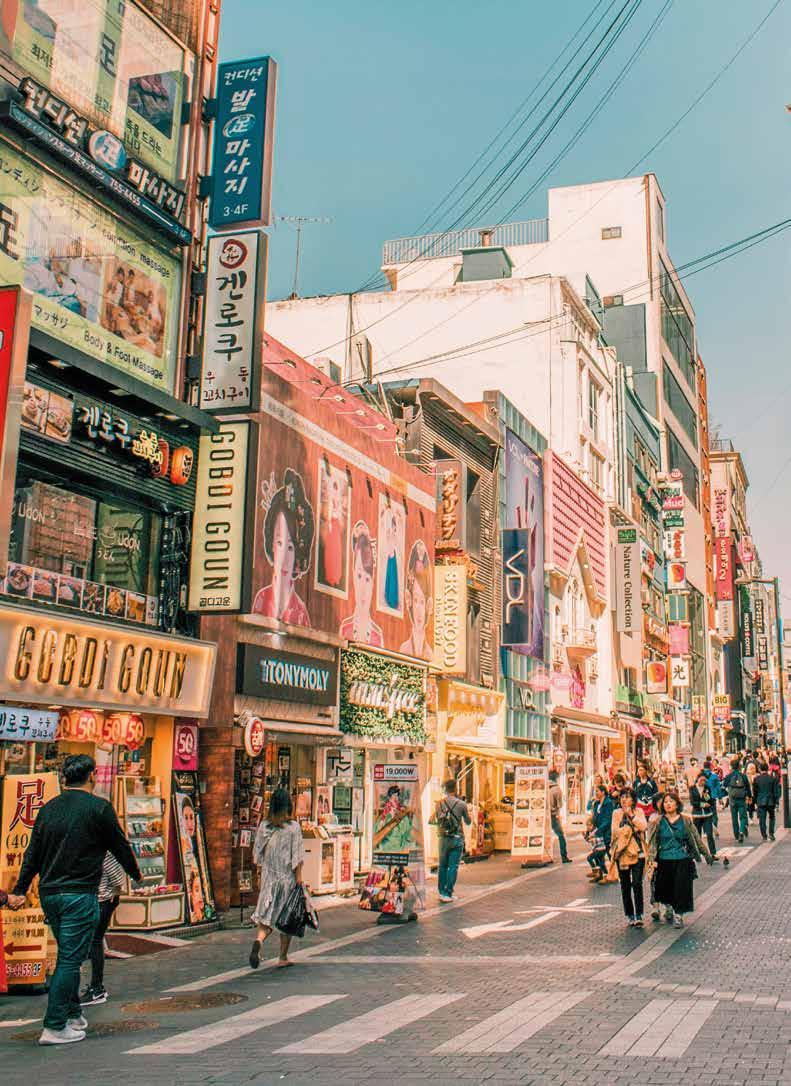

South Korea is really trending right now (K-Pop anyone?!), and it’s such an up-and-coming destination that we felt it deserved a spot in our portfolio. Korea is a natural second choice for all of those people who have loved visiting Japan, and who want to see something culturally similar yet totally new. The food, the service, the music and clothing – everything about South Korea seems to be hitting the zeitgeist right now, and our new trip is no different.


We’re excited to reintroduce the Deep South USA to our programme. Iconic places like Nashville, Memphis and New Orleans have always been perennial favourites, but we’ve also chosen to put the Appalachian Mountains in the mix. The Appalachians have their own music traditions of Bluegrass, but this is also a chance to see some of the USA’s natural beauty amongst an itinerary that can be city focused. The Deep South is one of the places in the US where Americana really comes to life, and the benefit of travelling on a small group tour is that the Tour Leader will know exactly which dive bars, honky tonks and blues clubs offer the best experience, and will get people tasting real southern food at local spots.

From wild Atlantic beaches to traditional tribal lands and friendly locals, West Africa has a raw and vitalising energy. Less visited than the east, it offers an array of exotic, once-in-a-lifetime experiences for adventurous travellers and is an area very popular with Explore customers. Set between Togo and Ivory Coast. Ghana has benefited from decades of stable democracy, earning the country its friendly ‘Gateway to Africa’ reputation. Our two-week varied and extensive itinerary really gets beneath the skin of this warm and welcoming country.
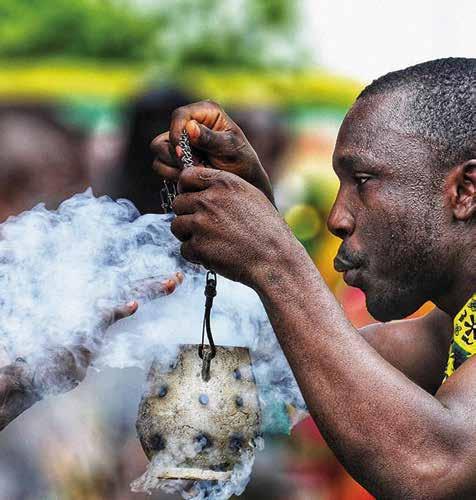

Our wildlife programme has seen big demand this year with destinations like Botswana, Namibia and Costa Rica becoming hugely popular. One of the jewels in the crown of our wildlife line has been viewing majestic mountain gorillas in their natural environment in Uganda, but this has been on pause due to travel advisories for Queen Elizabeth National Park. But now Uganda is back, with a brand-new itinerary that combines the endangered mountain gorilla in their natural habitat of Bwindi National Park with the chance to see Golden Monkeys in the spectacular Volcano National Park in Rwanda.
Didn’t know about these?
Sign up to be the first to know about any new tours, destinations and other shenanigans we’re up to. explore.co.uk/sign-up

A week’s hike through the ancient pathways of Turkey’s Cappadocia blew Eliza Sherlock’s mind. Now there’s no stopping her.
Words –– Eliza Sherlock
Opposite
The out-of-this-world landscape makes for incredibly diverse and interesting walking
As you read this, I will be hiking the Inca Trail. There’ll be rough terrain, challenging climbs and steep drops. But less than six months ago, I’d never even been on a walking holiday. I was outdoorsy, and I had a dog, which I guess means I had a moderate level of fitness, but we’re talking a gentle coastal stroll, rather than adrenaline ascents through clouds. So, what happened?
My walking trip to Cappadocia happened! Back in May I wanted to do something different. Trekking almost 80km in a week with a group of strangers was certainly different! Turkey had been on my hit list for a while as I’m a huge fan of the food, but I didn’t want to sit on a beach. The surreal fairy chimneys and ancient history of central Cappadocia had always intrigued me, and images of air balloon-filled sunrises over Goreme were enough to convince me to give the trip a go. And it didn’t disappoint as a destination. The rose-tinted valleys and volcanic scenery have given the region one of the most distinctive landscapes in the country. The backdrop is so dramatic, and our itinerary allowed us to feel part of it, without the crowds.
Our daily walks were little adventures in themselves. The paths were varied – sometimes slow, sometimes steep, occasionally tricky due to uneven terrain, but manageable in the main. It turns out my fitness levels were sufficient, but my kit wasn’t. Tip – if you have walking poles, pack them! Thankfully our guide had a set for me, giving me stability when the path was loose under foot. What I was grateful for having packed were walking boots with ankle support – when the terrain was wobbly, the ankle support helped my balance. Most paths we walked were wide enough to walk two-by-two, enabling our group to chat and socialise, hanging back to wait for those who needed more time. My favourite walk, Red Rose Valley, was the steepest and most challenging. You had to catch your breath at the top, not just because of the climb, but the view down to the valley, shining in the sunshine, was so rewarding.
Our hands-on tour leader, Aykut, helped bring our surroundings to life – he had deep knowledge about the history, architecture and cuisine of the area, and the best bits of our bus journeys was when he’d stand up the front, reeling off fascinating facts and insights. We lucked out on this trip as he had a trainee working alongside him too, so we were very well looked after.
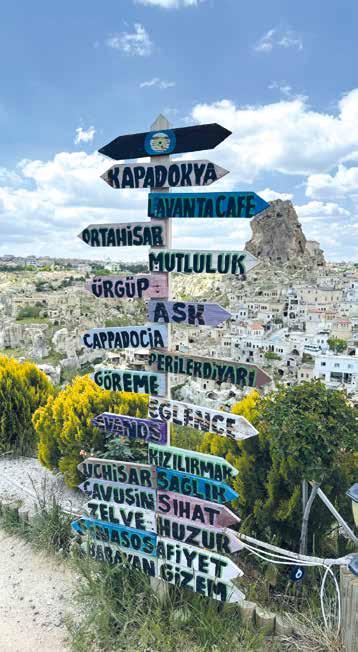
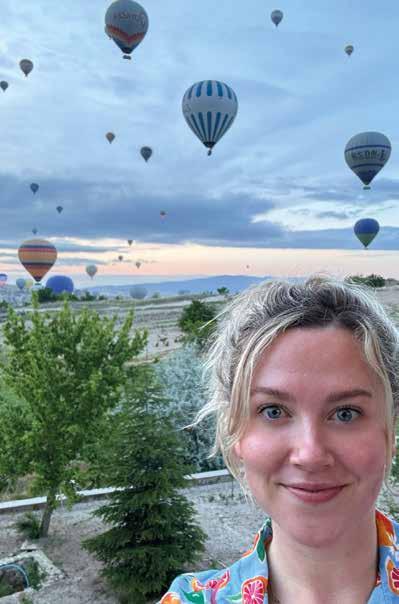
Looking back, I’m amazed how much we did, without it feeling rushed. We walked past local vineyards on our walks (very different to our own) and had a wine tasting in one of the neighbouring towns with wine made from local grapes – who knew Turkey had an ancient wine culture? We also explored the underground city of Kaymakli, a troglodyte cave settlement made up of nearly 100 tunnels spread over eight levels, getting smaller and smaller the further down you go! Four levels are open to the public –fascinating, if a little claustrophobic!
And of course there’s the cuisine. Hard for me to be objective here as it’s my favourite food and so I liked everything. If I had to pick my favourite dish, it would be the aubergine stuffed with a ragu-style filling, but we didn’t have a bad meal the whole week. Our hotel was an easy stroll to the restaurants of Goreme, and Aykut was great at recommending what to eat – and where! One night we had a cookery class at the hotel and made our own starters (think courgette and carrot fritter – delicious). We drank local juices and loaded up on pomegranate Turkish delight to take back home.

It was my first small group trip, and this was what had daunted me most (more than the trekking!) but the biggest surprise was how much I enjoyed being part of it. Our different walks of life were what made it work. We had so many laughs on our hikes, sharing our personal experiences and backgrounds, looking out for each other – it felt a real privilege. While we walked everyone integrated – there were never any cliques or exclusions, and I had ready-made dinner companions for the whole week. Booking a room to myself was the right decision though – it was nice to have some space and privacy at the end of the day.
“We had so many laughs on our hikes... it felt a real privilege”
One thing worth noting – the microclimate of the Cappadocia region means the weather can change –sunny one day and cloudy and breezy the next. May was comfortably warm, but our walking schedule did have to change due to cloud, so it’s good to have a flexible mindset. The infamous hot air balloon rides in Goreme that fill the sky as the sun rises are also weather permitting. I passed on the ride, but those from my group who went returned with stunning photos and memories. I think the sight of the balloons floating over the hotel as I woke was just as magical.
There were so many special moments during the week, but perhaps one that stood out was on the final day. We were walking through the Kiliclar Valley (also known as the Valley of Swords), when as if from nowhere a herd of 20-30 horses galloped through –seemingly in slow-motion and like something from a movie set. Surreal and beautiful.
And here I am, all signed up to hike the Inca Trail in Peru, one of the new Seven Wonders of the World. Cappadocia had cast its spell!
Walking in Cappadocia explore.co.uk/WGV
The little-visited Albanian Alps in the north of the country are (for now) still a well-kept secret. Stay in remote villages and catch glimpses of Albania’s traditional way of life while walking through the stunning Valbona and Theth National Parks. explore.co.uk/ALW
Explore India on foot with a walking tour through the diverse tropics of Kerala, India’s southernmost state. Not typically known as a hiking destination, Kerala will take you completely by surprise. Conquer Meesapulimala Peak (South India’s highest peak at 2,640 meters above sea level) to be rewarded with astounding views, or hike through tea plantations and forests, surrounded by local village life at every step. In-between exciting hiking days, board a traditional houseboat and enjoy a relaxing float along the famous Kerala backwaters. explore.co.uk/WIK
Looking for spectacular walking spots that aren’t on everyone’s radar yet? We’ve got the scoop for your next adventure!
Kyrgyzstan will blow you away with its incredible, untouched landscapes. Think huge lakes, towering mountain ranges (over 90% of the country is mountains!), and hidden waterfalls in ancient woodlands with giant walnut trees. Sounds like a dream? Well, it gets even better. This Silk Road gem will make you feel right at home with its hospitable locals and nomadic culture – who could resist a stay in a yurt? explore.co.uk/WKYZ
Head off the beaten path on a trekking tour through Georgia’s breathtaking Svaneti region, situated amongst the peaks and gorges of the snowcapped Caucasus Mountains. Explore places like Ushguli, one of the highest continuously inhabited settlements in Europe. Enjoy brilliant hiking with stunning views of green valleys dotted with koshki (stone towers built from the 9th century onwards), and of course, savour the country’s incredible cuisine, including khinkali and khachapuri explore.co.uk/WGEO
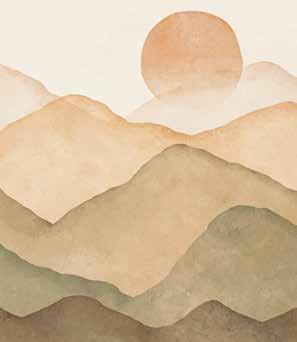
“Don your walking boots and meander through ancient olive groves and fields of wildflowers”
If you’re looking for a wintertime getaway, Northern Cyprus, and more precisely the impressive Besparmak Mountains running alongside the beautiful Mediterranean Sea, offers a perfect escape (with balmy temperatures) for walking enthusiasts. Don your walking boots and meander through ancient olive groves and fields of wildflowers, stopping for delicious meze at local restaurants. explore.co.uk/LNC

Every year people travel to Nepal to experience the country’s most famous attraction, the Himalayas, first hand. But when Breanna Wilson went to Nepal this year, she didn’t climb a mountain. For her, it was all about the magic of the single-horned rhinos.
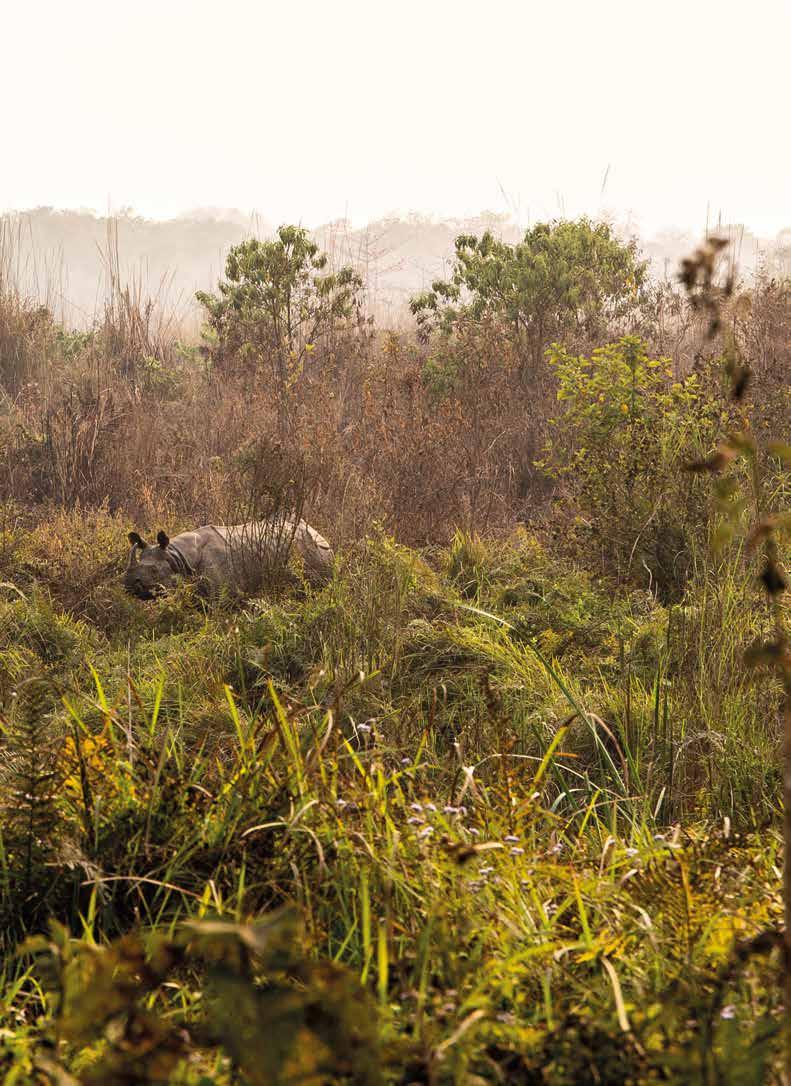
“There was something invigorating about being lost in the chaos of Kathmandu while wandering through the alleyways and rubbing elbows with the city’s inhabitants.”
Previous page A single-horned rhino, well hidden in the Nepalese countryside
Below Nepal’s architecture and locals just going along their day make for a highlight in itself
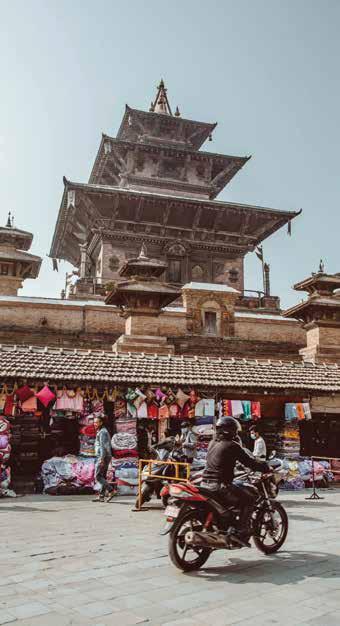
Most people think of climbing Mount Everest when they hear about Nepal, or at least trekking to base camp. It was my first trip, and I wasn’t quite sure what to expect, but I’d read about the history, the culture and, what most appealed to me, the mythical wildlife. I didn’t feel confident navigating a country as diverse as Nepal on my own, so a small group trip fitted the bill. The itinerary I chose included a bit of everything, from nature to city life, and all experiences I’d have had a hard time arranging on my own.
Temples, palaces and pilgrimage sites came first. Starting in Kathmandu, our first day was spent exploring the streets, our sights set on Durbar Square and Kumari Ghar, where we would be blessed by the Kumari, a very special experience to say the least. After, it was onto the Temple of Pashupatinath, Buddhanath, and the Boudha Stupa Thangka Center to do a deep dive into the country’s history and its people’s beliefs. There was something invigorating about being lost in the chaos of Kathmandu while wandering through the alleyways and rubbing elbows with the city’s inhabitants.
From Kathmandu we travelled to the city of Bhaktapur, known for its Newar traditions, including incredibly detailed wooden doors and windows, and elderly women donning sacred traditional tattoos. Bhaktapur also happens to be the city most devasted by the April 2015 earthquake, a destructive natural disaster that destroyed many of the buildings around the city. The damage and devastation the earthquake caused continues to haunt the city, with traces of the rubble still evident today.
We ventured on to the hilltop town of Nagarokot and the magnificent Fort Resort. It was here where we would spend the evening, as well as the following early morning, taking in the stunning views of the Himalayan Mountains in the distance. Enjoying a local Barahsinghe beer in the luscious gardens of this hidden gem of a hotel was a highlight of the trip for its serenity and beauty.
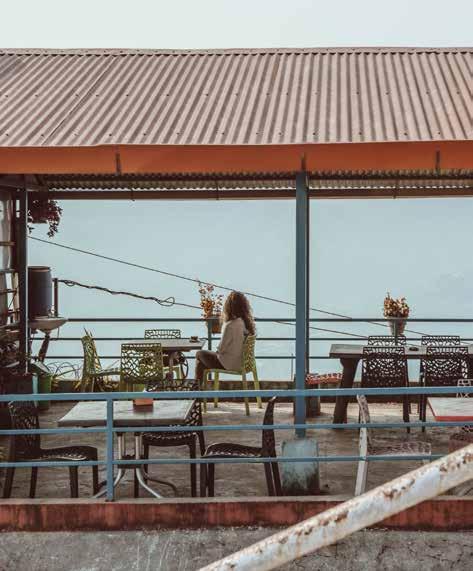

“With around 450 bird species found within the park, including several types of kingfishers, falcons, treecreepers, and dippers, and a fantastic night owl walk led by our park guide, there was always something to see.”
But it wasn’t all sacred must-sees and iconic views. Travelling through the Gorkha area, we embarked on a white-water rafting trip down the Trishuli River! Flying through the stunning scenery, along rapids named Lady’s Delight, Surprise!, and Butterfly, it was a great introduction to Nepal’s more adventurous side.
Finally, though, it was time to visit Nepal’s first and oldest national park, Chitwan, the place I had been most passionate about on our itinerary. The national park is home to the very rare single-horned Asiatic rhinoceros and is also one of the last refuges of the Bengal tiger. This was the reason I had come, and I couldn’t have been more excited.
With our park guide in the lead, we learned how the park had only just reopened, having been closed for four months after a tiger killed 13 people. Eventually, rangers were able to capture the tiger, a young male, allowing the park to safely reopen for visitors. Our timing couldn’t have been luckier.
Inside the park, the bird watchers in our group were immediately and constantly in awe. With around 450 bird species found within the park, including several types
of kingfishers, falcons, treecreepers, and dippers, and a fantastic night owl walk led by our park guide, there was always something to see.
Our second day inside the national park included rowing in dugout canoes down the Rapti River. This time, it was the gharials we were in search of. Gharials are one of the world’s most endangered and longest of all living crocodilians. There are only a few hundred living in the wild and we were very lucky to be rewarded with some close-up encounters with them.
Just when I thought the trip had reached its peak, an afternoon walking safari leapt to the top of my many memorable experiences in Nepal, both in and outside of the national park.
It wasn’t long into our walk before we spotted a mother and baby one-horned rhino, resulting in a nerve-wracking stare down before the pair decided to head off deeper into the elephant grass.
“When you realise how truly gigantic these mystical creatures are in the flesh, and looking directly into their eyes, you quickly understand just how powerful nature can be.”


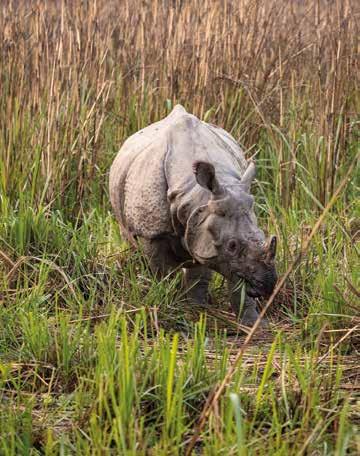
To say I could feel and hear my heart beating through my chest is no exaggeration. When you realise how truly gigantic these mystical creatures are in the flesh and look directly into their eyes, you quickly understand just how powerful nature can be. The ground shuddered as they stomped away, and it was only later I realised how easily the mother could have decided to charge instead. In that instance, we would have had to put the park guide’s earlier instructions to hide or climb a tree to use – you could never outrun a rhinoceros!
To the group and guide’s relief, instead she let us be. Leaving us only with one of those wildlife experiences that is felt deep in your soul.
When I think of Nepal, I’ll remember the stunning views of the Himalayas, of course. But our sightings of those beautiful creatures in their natural habitat was a privilege beyond all expectations.

Breanna Wilson is a travel writer specialising in overland, adventure and solo travel. She travelled on Explore’s Discover Nepal tour in February 2023.
In case you were wondering, Breanna joined the 15-day Discover Nepal Tour. You can find out all about it on explore.co.uk/DN
If you love wildlife and feel inspired by Breanna’s Nepal adventure, we’ve got a list of amazing animal encounters for you. These unforgettable experiences let you see incredible creatures up close in their natural habitats, a highlight for any animal-loving adventurer.
Tigers
Is it your dream to see the king of the jungle? Join us on a trip through Ranthambore National Park in India and see the Bengal tiger in its natural habitat. explore.co.uk/WSI
Elephant
Botswana is a wildlife paradise in and of itself, but Chobe National Park is an absolute highlight for anyone wanting to see loads of elephants. Large herds of them converge along the Chobe riverfront near the Okavango Delta during the dry season – a feast for the eyes. explore.co.uk/BW
Sloth
Are you ready for an encounter of the slow kind? If so, it’s time to head to Costa Rica, a tiny country containing 5% of the world’s biodiversity, to hang out with its inhabitants, the slow-moving sloths. explore.co.uk/CC
Lemur
Have you always wanted to spot a lemur in the wild? You’re in luck! There are over 110 different species of lemurs on Madagascar, and on our walking tour you might be lucky enough to spot a couple of them. explore.co.uk/MF
Polar bear
Did you know that polar bears have black skin beneath their fur to better absorb and retain warmth from the sun? This is just one of the many fascinating things you’ll learn on a trip to Norway’s Svalbard, where you can witness these majestic creatures in their natural habitat.
explore.co.uk/GMSO
Gorilla
If the mysterious mountain gorilla tops your bucket list, we suggest heading to Bwindi National Park in Uganda. Trekking through the jungle to see these primates up close is the ultimate wildlife encounter. explore.co.uk/UGR
Here’s a peek into some of the latest news and happenings at Explore.
The Explore Foundation was established last year to positively impact the lives of communities worldwide, and to further strengthen the relationship between those communities and our travellers. Here, Explore’s Sustainability Specialist Hannah Methven updates us on the Foundation’s progress – in numbers.
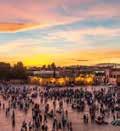
£61,267
donated via the Red Cross to help in the immediate aftermath of the Morocco earthquake
trained up through Lehara on the Everest Base Camp route
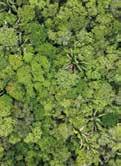
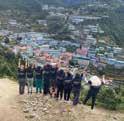
planted to support newlyrelocated communities in rural Cambodia

donated to St Vianney’s school in Kampala, Uganda, enabling children to study in comfort
put through the DevTog4 life skills programme with Lone Buffalo, with 25 workshops from CV writing to reproductive health
5,000 SOLAR LIGHTS
provided to students in Cambodia living without mains electricity, to help them study after dark
donated to girls in rural Cambodia through the Cambodia Rural Students Trust
50 BIKES
donated to Women on Bikes through One Bike, Tanzania
Keep up to date with our projects and initiatives at theexplore.foundation
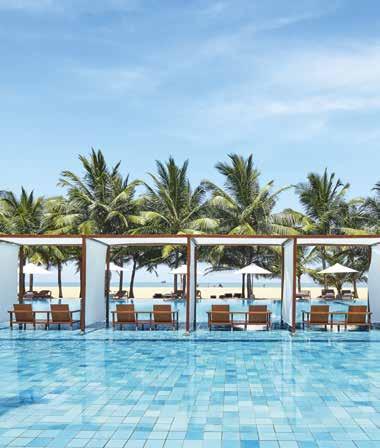
Our newest collection, Explore Upgraded, is everything you know and love about an Explore holiday – small groups, expert Tour Leaders, unforgettable experiences with a light footprint – with upgraded stays to offer extra comfort at the end of a long day’s exploring.
We’ve 18 Explore Upgraded trips to choose from, from walking in Italy and cultural Turkey, to a Botswana wildlife safari and cycling in Vietnam.
Accommodation has been chosen in our usual way – wherever possible, we stay in locally owned and run hotels for a more authentic experience that keeps tourism money in the local economy, and we always prioritise location so you’re right in the heart of the action. But tours in our Upgraded collection will typically use 4-star rather than 3-star properties, offering just that little bit
more comfort when it comes to your accommodation and facilities.
There are a few exceptions to this. Where we feel the experience warrants it, there are occasions where ‘comfortable’ accommodation is still your best bet. Staying in a converted Rajasthani palace, for example, or on a houseboat on the Okavango Delta –while the stay might not be premium, we’re confident that your experience will be.
In addition to Upgraded accommodation throughout your trip, these new tours also feature a special meal or dining experience –usually on day 2 or 3 of your trip –to welcome you to your destination and help you get to know your fellow travellers. We’ve also included (at least) one real stand-out experience or activity that brings your trip to life, or heightens your experience of this destination. This is where the memories are made.
See more at explore.co.uk/upgraded
Recipe
As suggested by our lovely Tour Leader Pok on page 30, the green curry is a Thai staple. The secret to a delicious curry is the homemade curry paste, ground by hand in a pestle and mortar.

Ingredients
1 tsp sea salt
5 long green chillies, sliced
5 green spur chillies, sliced
3 tbsp galangal, finely sliced
2 tbsp lesser galangal, finely sliced
3 lemon grass stalks, sliced
1 tbsp lime zest, finely grated
Method
3 coriander roots, finely sliced
4 shallots, sliced
1 garlic clove
1 tsp shrimp paste
1 tbsp coriander seeds, roasted and ground
1 tsp cumin seeds, roasted and ground
5 black peppercorns, crushed
1. Finely grind the salt and chillies, using a pestle and mortar or a food processor
2. When you have a smooth paste, add the two types of galangal, the lemongrass, lime zest and coriander roots and keep grinding or blending until the paste is smooth again
3. Next add the shallots, garlic, shrimp paste, ground seeds and peppercorns and grind/blend until the finished paste is smooth
4. This curry paste will keep in the refrigerator for 4–8 weeks if it's stored in an airtight container. To keep it even longer, pop freshly made curry paste portions into the freezer so you can defrost just one whenever you need it. Once frozen, these will keep for up to 6 months
Whether it’s a hunk of fresh baguette, steaming hot churros, or an all-inclusive buffet, there is something special about breakfasts away from home. Food writer Clare Finney explores breakfast traditions around the world and why it remains the best meal of the day.
Words –– Clare Finney


As a child, I loved breakfast. The thought of a bowl of Shreddies was enough to get me out of bed in the morning. Perhaps it’s because a bowl of Shreddies was the one source of consistency my divorced parents could offer in a life spilt between two houses. Perhaps I just loved the strange Shreddies character, and the concept of ‘keeping hunger locked up until lunch’. Yet like many things – my flexibility, my freckles, my love of puddles – my appetite for breakfast faded as I matured, and breakfast became less of a meal to enjoy and more a chore to be got through.
Apart from on holiday, of course. Abroad, under the morning sun, breakfast sheds its associations with monotonous work and morphs into something fresh and appealing. Mostly I think that’s because we morph, too; we slough off our pale office skins, grow a holiday glow, and our perspective shifts. Mornings aren’t so horrendous because we’re well rested. Yet it’s also, obviously, because of the food; because what we grab before or on the way to work bears little relation to the fare offered abroad; from countries with different ingredients, seasons and crucially, a different culture around eating.
Food historian Pen Vogler points to the Industrial Revolution as partly responsible for the idea that “speedy calories are a good thing; breakfast should be instant fuel, for humans which need an instant start button.” During the 19th century, people in factories worked 14 to 16 hours a day, with little time to eat. For most people, food was just energy, not something to enjoy. Then came the 1950s and 60s, (when “wherever America went, we blindly followed,”) which ushered in the cereals and cereal bars – foods which furthered this idea that breakfast should be convenient above anything else, with a nominal (and false) air of healthiness. The result has been a breakfast culture that is quite distinct from countries where breakfast is like any other meal: something to be enjoyed, by oneself or in company.
Of course, the English Breakfast is an exception to this –but unless you’re a regular of your local greasy spoon, this too is a treat confined to high days and holidays. That said, if you’re looking to understand why breakfast abroad is better, this leisurely meal centred around egg and bread is a good point of entry. “The one universal for breakfast appears to be eggs,” says Ed Smith, author of A Good Egg. How they’re cooked and how they’re served varies from country to country, but the eggs themselves are a constant. “Historically, people around the world have kept chickens in rural areas, so eggs are an easy, cheap, wholesome protein source – which is why they are such a breakfast staple.”
Smith is well versed in global varieties, from Mexican huevos rancheros – eggs with chillies, tomatoes and peppers – to the joyfully named Ugandan ‘Rolex’. “It’s a light omelette rolled in a chapati, and it’s more of a morning street food item than a recipe,” Smith says.
It’s as delectable as it sounds – but it’s also a great example of how “egg breakfast dishes, being the base for local spices and different ingredients, can provide a neat insight into local food culture and a country’s culinary history.”
The name Rolex, as you’ve probably guessed, is a nod to the expensive brand of watch. Apparently, there’s a saying in Uganda: ‘we don’t wear Rolex; we eat it.’ “The chapati was brought by Indian migrants to the country,” notes Ed. First forced over by the British to work on the railways in the 1900s, and subsequently, violently forced to leave in the 1970s by President Idi Amin. It’s a shocking heritage, but today the Rolex remains an integral part of Uganda’s food culture; a dish that is irreducibly Ugandan, like pan con tomate in Spain, baguettes in France or blueberry pancakes in the USA. Simply to eat them is to get a better sense of a country’s national identity –or at least the identity they’d like you to believe.
“Having the best British bacon you could provide as well as Indian kedgeree, was a way of showing domestic and imperial reach.”
One could argue this of all meals abroad of course – but it is particularly true of breakfast, being the meal with the most limited menu, style and time frame. Go to a typical café in Spain, and you’ll be offered pan con tomate, tostada, tortilla or churros. Go to the French equivalent, and it’ll be baguettes or pastries. The exact nature of these dishes will vary from region to region: the churros vary in shapes and consistencies across Spain, in France the brioche is
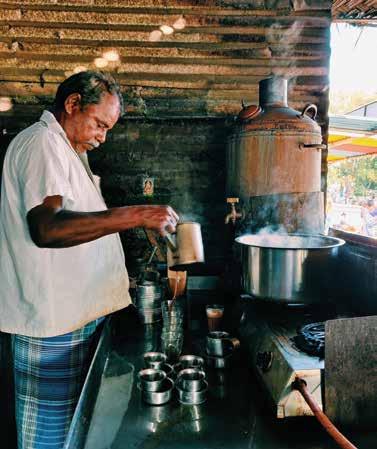
more popular than the croissant towards the south – but the selection is generally confined to what is typical of that place. “Unless you go to a supermarket, it’s hard to get a bowl of cereal,” Smith says.
Eating a hunk of buttered baguette alongside a strong café on a Parisian pavement, or churros in a Spanish square dappled with sunlight, one feels even just fleetingly part of that country’s way of life. This is true even in places where breakfast is more of an afterthought; in Italy, breakfast tends to be “coffee and a small, sweet pastry, eaten in a rush,” Smith says. The great Italian-born food writer, Anna del Conte wrote that in Italy, “breakfast is not considered as a meal” which perhaps explains why. Although Italy is not a country one associates with a fast pace of life, the espresso bars of Italian cities are buzzing at breakfast time. “Hurry up!” I remember my brother whispering, as I lingered over my cornetti whilst breakfasting with him in Rome, his adopted home. “Breakfast is more of a sub-ten-minute thing in Rome.” I was reminded of grabbing a bagel and a coffee in New York. It’s not an unenjoyable experience; it’s part of the energy.
These places where parameters of breakfast are strictly defined are a far cry from Britain’s breakfast landscape, where a week of cereal bars become weekend brunches in hip coffee shops-cum-restaurants. There you can feel overwhelmed by choice; by a meal that spans 8am to 5pm, croissants and juice to curries and cocktails. Personally, I prefer to be told that my options are limited at breakfast; for my fork to be forced into nasi lemek (a coconut infused rice dish with anchovies) or pompe a’ l’huile (a brioche with olive oil and orange water). Yet there’s a counter argument here, which is that the very same attitude that fuels our eclectic, overwhelming brunch culture is precisely what makes us so excited about breakfasting in other countries.
“In Britain we go mad for new stuff. We’ve always been absorptive, when it comes to food, and status has often come from being open minded and metropolitan; from eating Mexican one day and Greek the next,” says Vogler. Even in the Victorian era, breakfasts for the wealthy were often international. “Having the best British bacon you could provide as well as Indian kedgeree, was a way of showing domestic and imperial reach.” Which brings us, almost inevitably, to the breakfast buffets of all-inclusive


Above
Keep it simple. Italian breakfasts tend to be a quick affair.
Nevertheless a coffee is a must
western hotels: big, bottomless, global in scope and thus, ironically, perfect for the British palate. These days, it is cooler to scoff at than scoff down the hotel buffet, and to hunt out some small indie cafe. But I love it, as much as the next greedy Brit on holiday.
“In Italy, breakfasts tends to be “coffee and a small, sweet pastry, eaten in a rush”
With local specialities, Full English components, fruit, yoghurt, cereal and pastries, all under the same roof, it is everything and anything you want it to be, a means of showcasing one’s culinary identity. Show me a breakfast buffet plate, and I’ll show you the person. The only station from which almost all Brits will steer clear is that plate of
sliced cheese. “We are absorbative eaters,” laughs Vogler, “But for some reason, I don’t know what, it still feels nuts to breakfast on cheese.”
So, what’s on your breakfast plate?

Clare Finney Food journalist, writer, and author of The Times Food Book of the Year 2023 ‘Hungry Heart: A Story of Food and Love’ @finneyclare
If your favourite meal of the day is your first one, why not go on a gourmet adventure to one of these delicious destinations?
Imagine walking up to your breakfast table in a riad and being served a variety of platters, including delicious flaky mesemen (flatbread) or baghrir (pancake-like crepes) with honey and butter, and amlou (a spread made from almonds, argan oil, and honey). You’re also likely to get olives, fresh fruit, and maybe a boiled egg with cumin and salt—all topped off with sweet Moroccan mint tea.
explore.co.uk/XMR
If you prefer a savoury breakfast, Japan is the place for you. Being an incredible culinary hotspot, it comes as no surprise that the Japanese absolutely rock the most important meal of the day. It all starts with a staple bowl of steamed rice that will be accompanied with small individual dishes that allow a variety of flavours and textures – namely tamago (a Japanese omelette), tsukemono (pickled vegetables), grilled fish, miso soup, and steamed or sautéed vegetables. explore.co.uk/XJF
Another place that understands the joys of a good breakfast spread is Turkey. Sit down and feast your eyes on a variety of dishes that come together for an incredible meal. Fresh simit (sesame-crusted bread) or pide (flatbread) serve as a base to enjoy a selection of cheeses, olives, fresh tomatoes and cucumbers, jams, and honey. Be sure to also try menemen (scrambled eggs with tomatoes, peppers, and spices) and börek (savoury pastries filled with cheese, spinach, or minced meat).
explore.co.uk/XTU
Mais oui! If you’re after a simple and elegant breakfast, no one does it better than the French. A crispy fresh baguette or croissants with jam and butter await you, along with pain au chocolat (or chocolatine if you’re in the South of France). Add some yogurt with fresh fruit on the side and finish it all off with a café au lait (coffee with hot milk) or an espresso, and you’re ready to start the day. explore.co.uk/XFR
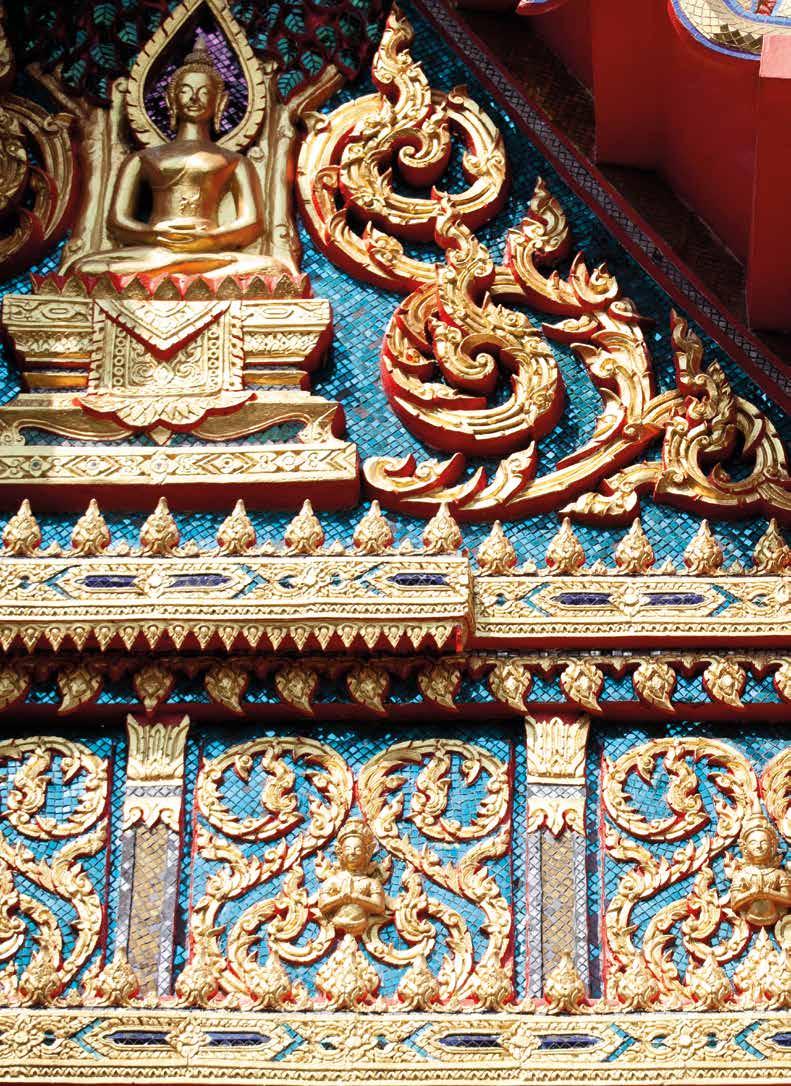
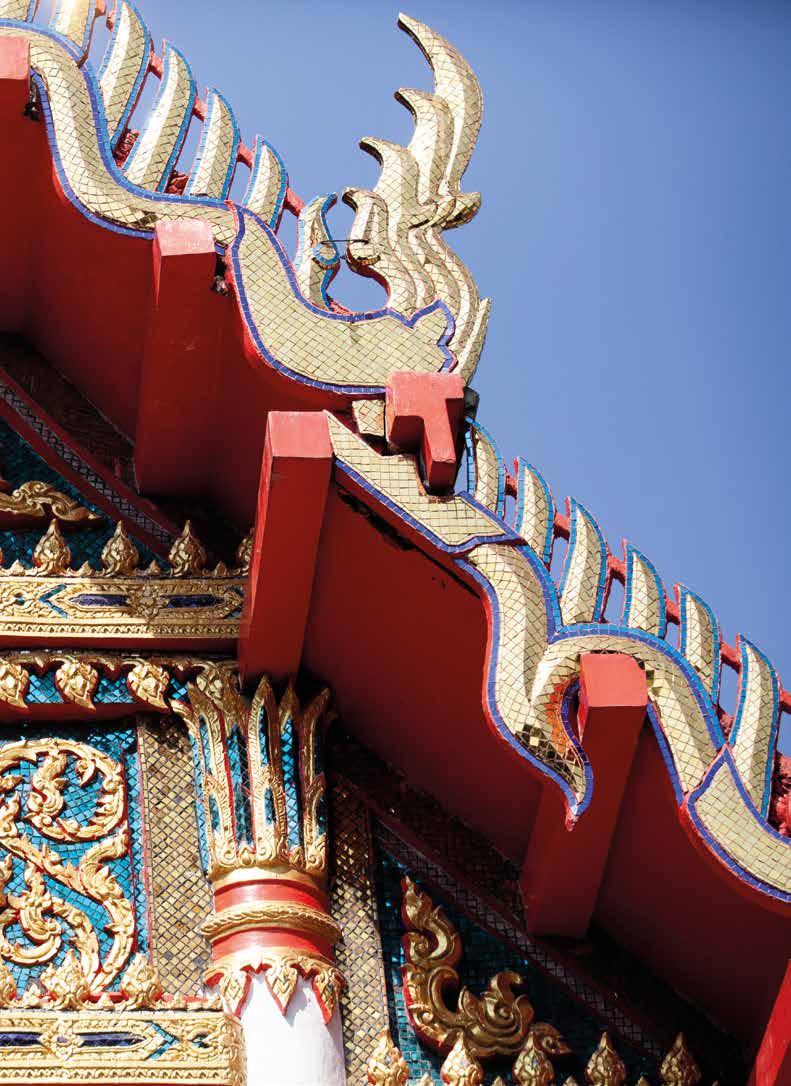
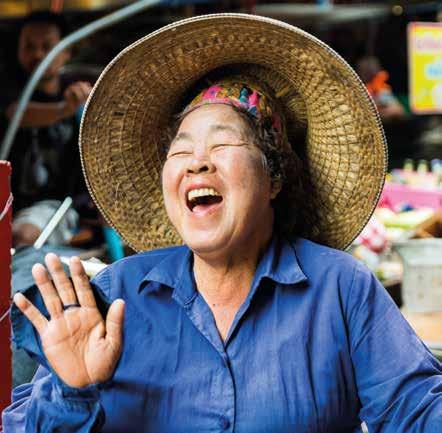
Movie-perfect beaches, top-tier temples, heavenly food, enchanting rainforests and glittering cities to boot. In fact, whatever you want from an adventure, Thailand has got it. But where to start? Here’s what you need to know.
Bordered by Myanmar, Laos, Cambodia and Malaysia, Thailand is located at the heart of Southeast Asia. Visitors typically arrive in Bangkok before heading north or south (or both!). Northern Thailand is packed with rugged mountains, honey-hued canyons and sprawling countryside, but remains lesser visited than southern Thailand. Splintering into a strip of land between the Gulf of Thailand and the Andaman Sea, southern Thailand’s beaches and islands are synonymous with laidback beach life, bustling nightlife and some of the world’s best snorkelling and diving spots.
Known historically as Siam, Thailand literally means ‘land of the free’. Its 13th-century Sukhothai Kingdom was the cradle of Thai civilisation as it heavily influenced Thai culture – King Ramkamhaeng created the Thai script – while the 14th-century Ayutthaya Kingdom thrived as a major power across southeast Asia. In 1782, King Rama I founded the Chakri Dynasty which still reigns to this day, and established Bangkok as Thailand’s capital city.
Spanning several millennia of rich (and sometimes turbulent) history, Thailand’s fascinating heritage is best explored at ancient sites like Ayutthaya – an easy day trip from Bangkok – and Sukhothai. Local communities continue to practice centuries-old crafts; in
Before you go:
The book to read: Bridge on the River Kwai by Pierre Boulle
The film to watch: The Beach by Danny Boyle
The music to try: Thongchai “Bird” McIntyre
The podcast to listen to: Thailand: A Royal Food Legacy –The Food Programme
Na Ton Chan, villagers use bamboo-made instruments to create intricate textiles and items. Today, Thailand continues to build on its unique, vibrant identity with an exciting modernity that ripples across major cities, from Bangkok to Chiang Mai.
It’s clear to see why Thailand is ‘the land of temples’ – there’s over 35,000 spread across the country! From Bangkok’s golden-topped Grand Palace to Chiang Rai’s sparkling-white Wat Rong Khun, there are countless opportunities to connect with Thai Buddhist culture with a temple visit – just remember to cover your knees and shoulders at religious sites.
Thailand is also home to an abundance of nature and wildlife. Khao Sok National Park is one of the oldest jungles in southeast Asia; learn about the elephants, tigers and birds that call this lush rainforest home with the help of a local guide as you traverse its jungle trails. When it comes to wildlife, research is key. The sprawling Elephant Nature Park in Chiang Mai is one of the most ethical places to see these giant creatures. As for Thailand’s natural attractions, there are plenty of cascading waterfalls, rewarding viewpoint hikes and longtail canal trips that highlight the country’s natural wonders.
Tap into Thailand’s more recent history in Kanchanaburi, located 128km west of Bangkok. As you cross over the Bridge over the River Kwai, visit the Allied War Cemetery and ride on the train along the Death Railway, you’ll gain a fascinating, albeit harrowing, insight into one of the most infamous episodes of the Second World War.
Thai cuisine is deeply rooted in the country’s history and culture, with influences from China, Malaysia and other neighbouring countries. Thai ingredients typically include fresh herbs like lemongrass and basil, creamy coconut milk, and rice and noodles to create
“There are plenty of cascading waterfalls, rewarding viewpoint hikes and longtail canal trips that highlight the country’s natural wonders”
some of its most traditional aromatic dishes. You’ll find that chopsticks aren’t really used in Thailand – it’s more of a fork and spoon affair. While Thai cuisine has reached worldwide popularity, there’s nothing like tasting your way through Thailand for the real deal. In fact, Thailand’s food scene is a rite of passage: try local specialties, world-renowned street food and soul-warming staples from north to south, and everywhere in between.
Street food: Street food is a vital part of Thai culture. Locals and tourists alike throng the night markets and street vendors for grilled pork skewers, som tum (papaya salad), mango sticky rice and more. It’s one of the most immersive ways to taste the flavours of Thailand, one bite at a time. Throw yourself into the heart of the action at the likes of Bangkok’s Chinatown or Phuket’s Chillva Market.

Cooking classes: Booking onto a cooking class is a hands-on way to get a genuine taste of Thai cuisine – and a delicious way to learn. Cooking classes usually coincide with visits to local markets where you can see and buy fresh ingredients. With the help of local chefs, you’ll leave armed with the skills to recreate your favourite Pad Thai or green curry back home –talk about an epic dinner party!

There’s no denying that Thailand is loved for its beaches and islands. Crystal-clear waters lap golden-sand beaches, fringed by thick forest or tranquil tree-lined roads... nowhere does it quite like Thailand. There are over 1,400 islands scattered across the Gulf of Thailand and the Andaman Sea, and one of the best ways of getting around is by traditional longtail boat. As you glide across the waves, you’ll gain a true sense of Thailand’s incredible landscapes. Or get beneath the surface – quite literally – by scuba diving or snorkelling, where you might spot dolphins, turtles and colourful fish.
Thailand continues to show off with its karst-studded waters – take your pick of the best views from the beaches of Koh Lanta, Railay and Koh Ngai. There are popular places like Maya Bay on Koh Phi Phi, but seek out more secluded spots for the ultimate rest and relaxation. Come evening, some beaches up the ante with jaw-dropping fire performances, and of course there’s the hedonistic Full Moon parties on Koh Pha Ngan to dance the night away.
Thailand is the only country in Southeast Asia that has avoided European colonisation.
Bangkok's full ceremonial name is the longest city name in the world: Krung Thep Mahanakhon Amon Rattanakosin Mahinthara Yuthaya Mahadilok Phop Noppharat Ratchathani Burirom Udomratchaniwet Mahasathan Amon Piman Awatan Sathit Sakkathattiya Witsanukam Prasit!
The Siamese cat breed originates from Thailand; these elegant felines were much-loved royal pets during the Kingdom of Siam.
Thailand is home to the world's smallest mammal, the Bumblebee Bat, which is about the same size as an average bumblebee.
The energy drink Red Bull hails from Thailand. Thai businessman Chaleo Yoovidhya created Krating Daeng ('red guar') in 1976, before co-founding Red Bull in 1984.
Few understand the true diversity of Thailand better than Worasak ‘Pok’ Paiboon, one of Explore’s most respected Tour Leaders. We asked him to explain what makes his country so special.
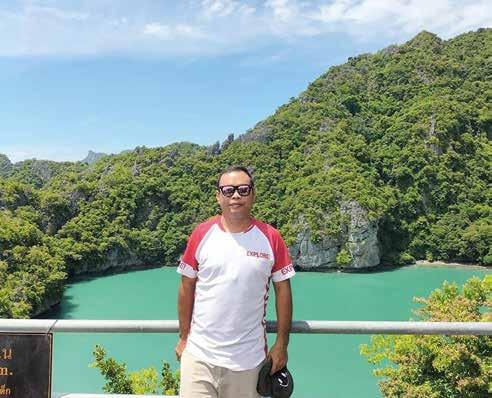
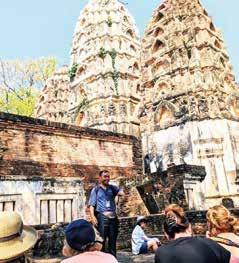
We‘re always smiling
“If you come to Thailand because you love the food, you won’t be disappointed!”
Do you know why Thailand is known as the land of smiles? We are big believers in karma. We are a Buddhist country – there are many beautiful temples to visit and learn about our belief and culture – and we are very respectful to our parents and the elderly. In Thailand, we believe in putting good vibes into the world and looking after each other! That’s why people in my country are lovely, smiling, friendly and ready to help whenever you need it!
We’re full of surprises
Think of Thailand and you think of busy, vibrant Bangkok and beautiful beaches like South Krabi, right? A night tour of Bangkok by tuk-tuk is a definite highlight (you must try eating salted crickets, and if you’re really brave, try a scorpion!), but the biggest surprise of all is our wildlife! Head out from Bangkok to the south where you’ll find the protected Kui Buri National Park. From giant monitor lizards to families of wild elephants it’s one of my favourite treks, I think because people don’t expect to see such incredible animals in Thailand.
We love to cook
If you come to Thailand because you love the food, you won’t be disappointed! I often share my own family recipes with our groups – and I always take people to family-run places that offer traditional dishes. Be warned, we love chilli! Everyone should try a real Thai green curry – you can choose chicken, prawn or tofu. Also try Pad Thai and Guay Tiew steamed noodles. My top tip? Charmgang restaurant in Bangkok – it’s hidden away down a side street, not too expensive but the food is out of this world – and it’s in the Michelin guide! Also Tichuca Rooftop Bar. But don’t tell anyone –it’s a secret!
We never stand still
I’ve been a tour guide with Explore for over 30 years, and I’m still learning. We improve our working practises every day, and our safety skills are always one step ahead of the rest. Our aim as tour leaders is to allow our guests to explore and discover new things and be daring but stay safe. It’s the best job –we get to discover new things too.

The joy of a holiday is often cemented by the books we take, triggering memories of happy trips years later when we reread or remember the story. Many of us choose tales that are rooted in the destinations we are travelling to. We asked book editor Natasha Poliszczuk about the correlation between travel and literature.
“I use all my senses to imagine myself in the setting: you cross the square and your hair feels hot; there is the smell of orange blossom; in a narrow side street the air is cool, you hear the clatter of pans behind barred windows.”
Joanna Glen

Statistically, a holiday is the time when people are most likely to read. A 2023 survey suggests that for one in four adults, it’s the only time they open a book. So better make it a good one! I am the type of person who books a holiday and immediately starts planning which books to take. They are as essential as sunblock and a passport, at the risk of excess luggage. And I am a keen proponent of matching at least one book to your destination. This has the benefit of broadening your mind and nudging you out of your literary comfort zone.
One of the great joys of holiday reading is that the process will lull your mind into an associative state. Forevermore, when you open that book, you will be transported back to, say, Berlin – that hip city that still bears the scars of the past (The Silence in Between –Josie Ferguson). To the village square in Cyprus where the dust swirled in the heat and the church bell tolled (Elif Shafek’s The Island of Missing Trees). Or the market in India, where you sought the shade and a moment of stillness. (The God of Small Things – Arundhati Roy; The Glass Palace – Amitav Ghosh; the epic The Covenant of Water – Abraham Verghese).
For the author as well as the reader, location is key. “Setting is one of the three most important elements of storytelling, along with character and structure,” says Charlotte Philby, whose slick, stylish literary thriller The End of Summer is set between London, the Languedoc and Cape Cod. Foreign locations give a novel
that “cinematic, escapist” element. “With a twisty thriller that requires the reader to suspect disbelief, strong, believable settings can anchor them in a particular place and time.” Philby is also a fan of matching her reading matter to her location: she read Polly Samson’s A Theatre for Dreamers in Greece and The White Tiger by Aravind Adiga in India. (For further Cape Cod action, open Miranda Cowley Heller’s The Paper Palace.)
For Joanna Glenn, who’s wonderful All My Mothers has lit a fire within me which shall only be satiated by a trip to Córdoba, setting comes before almost anything else. “It arrives in my mind, asking for a story. It’s accompanied by a feeling – in the case of All My Mothers, a non-specific sense of longing, defined as saudade. When I was writing the parts set in Cordoba, I use all my senses to imagine myself in the setting: you cross the square and your hair feels hot; there is the smell of orange blossom; in a narrow side street the air is cool, you hear the clatter of pans behind barred windows.” Other tried-and-tested Spain-set novels to throw in your suitcase: Homeland by Fernando Aramburu; Hemingway’s The Sun Also Rises
What I adore about destination reading is how it triggers memories, bringing your past to life. Whenever I open A Room with a View, I am 19 again, and shade-seeking in the Boboli gardens, wondering what Lucy Honeychurch and her Baedeker made of it. F. Scott Fitzgerald’s Tender is the Night takes me back to a train ride along
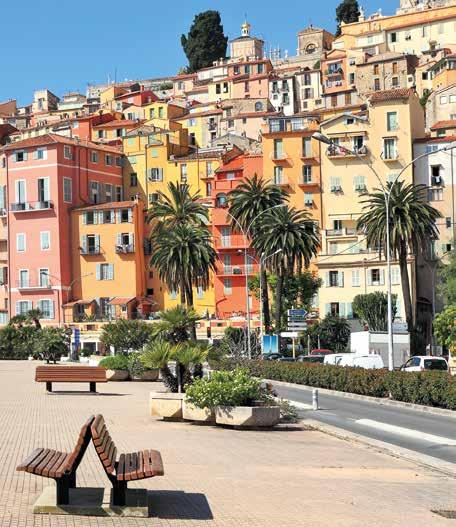
the southern coast of France from Nice to Menton – where I wandered through the Old Town to the harbour.
And what a thrill to be able to wear the shoes of authors and characters! I have walked through Steinbeck country with East of Eden and through San Francisco looking for the spirit of Sam Spade (The Maltese Falcon – Dashiell Hammett) whilst wishing I could write like Joan Didion – she writes about her home state of California in Where I Was From. On honeymoon in New York, I bought myself another copy of Edith Wharton’s The Age of Innocence from a sprawling second-hand bookshop, and walked over the Skyline with Betty Smith’s memoir A Tree Grows in Brooklyn in my hand. And in the grand Pera Palace hotel in Istanbul, I stood in room 411, where Agatha Christie stayed and wrote Murder on the Orient
Of course, the best books can take you soaring around the world without leaving your chosen reading nook. You might not have been to Africa but can feel the heat of Half a Yellow Sun (Chimamanda Ngozi Adichie) and walk through the plantations of Kenya courtesy of Karen
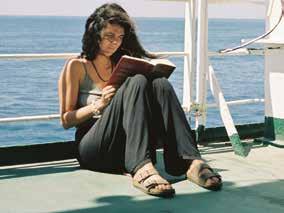
Blixen’s memoir, Out of Africa. You can trot around Paraguay thanks to Travels with My Aunt (Graham Greene); spend 100 Years of Solitude in Colombia with Gabriel García Márquez; and ride the Australian outback with Peter Carey’s The True History of the Kelly Gang
“I love novels in which the setting becomes a character of its own, a delicious world in which to travel, so that one feels transported.”
You can cross Russia with Pasternak’s Dr Zhivago and spend time with Amor Towles’ A Gentleman in Moscow. You can delve into Japan’s past with the Memoirs of a Geisha (Arthur Golden) or the modern Tokyo of The Wind-Up Bird Chronicle (Haruki Marakami). And I defy anyone to read Hema Sukumar’s Minor Disturbances at Grand Life Apartments and not feel like you are eating mangoes under the warmth of the sun in Chennai. And then there are writers who take it one step further. Tuga de Oro is a British overseas territory in the South Atlantic – a sun-drenched paradise of dreams. It is also entirely fictitious –it “shimmered into being” in Francesca Segal’s imagination and in the ultimate act of wish fulfilment, she immortalised it in Welcome to Glorious Tuga. “It is,” she admits, “absolute bliss to invent your own island. I did a lot of very joyful research because it mattered to me that just because Tuga de Oro doesn’t exist, that doesn’t mean it couldn’t.”
Francesca gets it: that almost indefinable magic in books’ ability to take us there: “I love novels in which the setting becomes a character of its own, a delicious world in which to travel, so that one feels transported. A character’s setting and environment alters her decisions just as a reader’s environment alters the way in which you respond to the book in your hands.”
The big question is: what comes first, the travel book or the travel booking? Happy reading!
Book club
Love good books just as much as adventures? Check out our new Four Corners Book Club on pages 34-35!

Natasha Poliszczuk is a journalist who writes and reviews books for leading publications such as The Times, The Telegraph and Glamour.
Substack newsletter: Book(ish) Instagram @natashapoliszczuk
If there’s anything our Explorers love as much as (or almost as much as) travelling, it’s reading. So we’re delighted to unveil the brand new Four Corners Book Club! This is your one-stop-shop for recommending your top travel reads, and browsing others’ recommended novels set in your next holiday destination. Here are a few of our favourites so far...
The Covenant of Water, Abraham Verghese
“Set in south India, this book really takes the reader there. A book which spans decades and throughout the theme of water and its influence on a family is its focus. At first I was intrigued with quite how water had such an effect on this family by the end it became ingeniously obvious. I read this book in the UK but I wish I had saved it for my next trip to India.”
– Kevin Sissons
Love in the Time of Cholera, Gabriel Garcia Marquez
“This is a real classic. It’s set at the turn of the 1800s to 1900s in Colombia and tells the tale of a love that is thwarted by an unimpressed father. It deals with the ups and downs of marriage, as well as the advantages and disadvantages of passion (the Cholera in the title represents both the illness, and “passion”). It also looks at love in older people, and at death. It’s a beautifully spun tale.”
–Jae Hopkins

Outback, Patricia Wolf
“This is the first in a detective series set in small town Australia. There are extremely believable characters and a great sense of place – heat, sweat and dust! – as well as a fast paced plot. I’m not sure if Wolf creates a place that a reader would want to visit, but the bleached out and dangerous setting is easy to imagine and hard to forget.”
– Alex Hobbs
The Summer Book, Tove Jansson
“Sharp and sweet, this is a novel about the relationship between a grandmother and granddaughter as they spend the long Finnish summer on a beautiful, quiet island. It captures both the freedom and fear of growing up and growing old, set against a backdrop of midnight sun and long summer days.”
– Aimee White

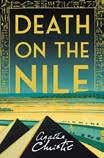
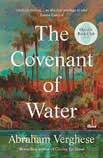
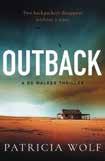
Death on the Nile, Agatha Christie
“If you’re travelling on the classic Egypt and Nile tour this book is a must read. The book visits so many of the places along the Nile. A highlight for me was the stop at Abu Simbel and the visit to The Great Temple of Ramesses II – the book describes the visit and characters in the book describing the different Pharaohs. The characters in the book returned to visit this great temple at night. Seeing the temple in daylight was an incredible experience for me and through reading the book I could imagine a night time visit and the impact of seeing the temple by moonlight, simply breathtaking I’m sure!
“A highlight for me was knowing that Agatha Christie wrote the book during a stay at the Old Cataract hotel. We visited this hotel for afternoon tea and it was fantastic to sit out on the veranda looking over the Nile. You could imagine Agatha doing the same from her hotel room with her old fashioned typewriter clicking away!
– Sarah Leonard
Before the Coffee Gets Cold, Toshikazu Kawaguchi
“If you were given an opportunity to visit the past, would you? Set in a mysterious café in Tokyo, this captivating and thought-provoking book explores the idea of finding closure with your past. This isn’t your average time-travel novel—there are many quirky rules that must be followed! I just wish this café existed in real life... Loved it, loved it, loved it!
“At the end of the day, whether one returns to the past or travels to the future, the present doesn’t change.”
– Sian Spiers
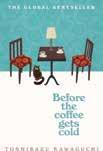

Read more reviews or add your own favourite reads at explore.co.uk/bookclub
Reviewers will be entered into a prize draw to win a £5,000 Explore voucher.



Just in time for the spookiest day of the year – Halloween –Explore’s Amy Fiske (who, in her own words, ‘travels for anything weird’) takes a trip down the lesstravelled roads of mythical creatures who have inspired the nightmares of countless generations.
hat I love about ghost stories is that they can tell us about the modern history of a community. But fairytales and folklore can go back even further! These are my favourite mythical creatures from across the globe that demonstrate humanity’s need to explain the unknown (and to keep naughty children in check).
1
The Bunyip, Australia
Australia’s wetlands are home to a mysterious creature known as the Bunyip or ‘Mulyawonk.’ According to local Aboriginal stories, the Bunyip, often described as a water-dwelling, dog-like creature with tusks and flippers, eats those who catch too many fish or disturb the waters at night. As efforts to rewild and restore these ecosystems continue, tales of the Bunyip have resurfaced to the mainstream media. Known as an evil spirit, for centuries aboriginal children were taught to respect the wild... or else.
2
3 W Left
The Wendigo, Canada
We’re about to get gruesome here. Natives and early settlers in Canada had to deal with extreme winters, making agriculture almost impossible and the need to store enough food for the winter a life-or-death matter. Do you see where I’m going? The Wendigo is a person who lost their humanity after consuming human flesh. Always depicted as a malnourished humanoid, the Wendigo will come for anyone partaking or entertaining the idea of nibbling their neighbour.
Selkies of the Scottish Isles
Whilst the UK’s flora and fauna are much milder and tamer than in Canada (they consider big cat sightings as mythical, see ‘Bodmin Beast’ and Lake District sightings), they do have incredible coastlines curving around the Orkney Islands. These views are captivating but keep an eye out for seals as they may, in fact, be Selkies. Like mermaids, Selkies are ‘fin-folk’ that present as seals in water but once they reach land, they shed their seal skin to uncover a beautiful woman or man underneath. It is said that both men
“My favourite mythical creatures from across the globe demonstrate humanity’s need to explain the unknown (and to keep naughty children in check).”
and women can be swayed from their martial beds by the beauty of the Selkies. In one case a fisherman was reported to have taken a female selkie as his bride.
The Ogre Fountain in Bern, Switzerland.
In Bern, Switzerland, near the original city limits, you’ll find a curious fountain. At the top of this fountain is a sculpture depicting an ogre eating babies. While no one is exactly sure why this was built over 500 years ago, Explorer’s editor Michelle has a theory. “In Switzerland, where I grew up, there were always stories of monsters ready to eat wandering children.” Could this fountain so close to the city gates be a warning not to leave the safety of the city at night? Perhaps the risk of being gobbled up by an ogre if you strayed too far was enough to keep you close to home. Yep, works for me!
Below
Did you know that the word ogre is of French origin, originally derived from the Etruscan god Orcus (the god of the underworld), who fed on human flesh
Not to be confused with the Texas Chupacabra, the Puerto Rican Chupacabra is a cryptid classic next to Big Foot himself but much younger. This fanged blood-sucking reptile/doglike creature terrorises livestock farmers (and in 2004, a petting zoo). Yes, vampire bats are common in South America but like wild dogs, they’re messy eaters so it can’t be the without-a-trace Chupacabra. Similar spotted creatures in Puerto Rico go back to a 1950s UFO sighting. So, what is the Chupacabra? Vampire dog? An undiscovered creature? Or maybe the perfect criminal?
In the spirit of monsters terrorising children, I’m excited to be travelling to Salzburg for their ‘Krampus Run’ Christmas celebration this year. Krampus is like Santa’s evil twin, he’s the one that drops off the coal and if you’re still awake he’ll spank you with birch twigs. I’m looking forward (if a little nervous) to be chased by some incredible Krampus impersonators. I’ll report back.

No worries, we’ve got some ideas for you. Best of Romania and the Danube Delta
Need we say more! A classic destination for fans of ancient customs, myths and of course the Dark Lord Dracula himself. explore.co.uk/TD
Contrasts of Mexico
Thanks to its indigenous culture, Mexico has a wide range of stories and old traditions that are waiting to be discovered. Dia de los Muertos specifically is a big nationwide celebration that you shouldn’t miss! explore.co.uk/MX
Walking Scotland’s Orkney Islands
Where there’s stone circles, iron age villages and Scottish castles, a good ghost story is usually just a cozy evening with a whiskey away. explore.co.uk/ORK
Here are some of our amazing Tour Leaders, while out and about, showing our customers their homes.
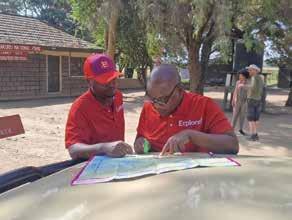
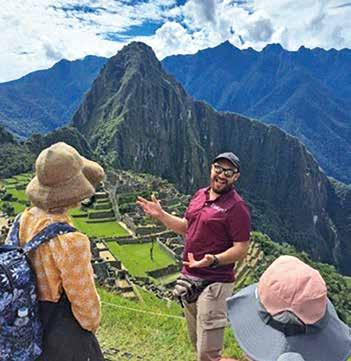
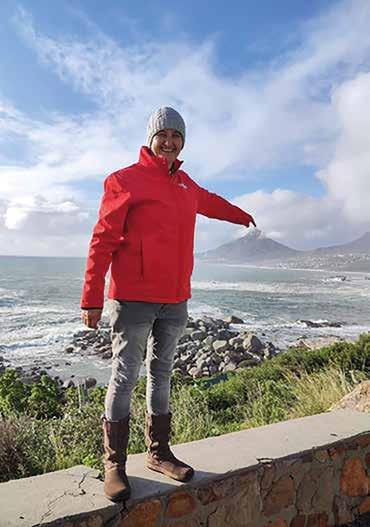
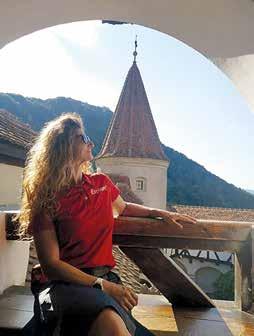

Belize is a gem that will take you from spectacular to unbelievable with its mix of exotic wildlife, lush forests, white-sand beaches, and ancient sites. Visit and dive into some of Central America’s best snorkelling spots, explore the Crooked Tree Wildlife Reserve for local wildlife, and discover the ancient Maya temples at Xunantunich and Lamanai.
Check out our discovery and family tours in Belize now.

Find out more

